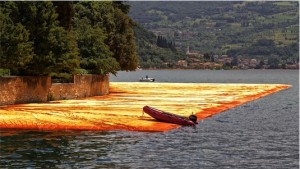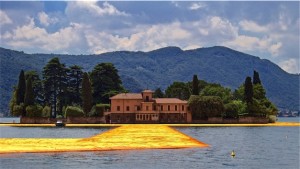How to walk on water
Ever wondered how to walk on water? Well, for a brief time this summer, it is possible.
Is this heaven? No, it’s the Bresciano.
Lago Iseo is Italy’s hidden gem, a lake mostly known only to Italians. Sandwiched between Bergamo and Brescia in Lombardy, it has long been overshadowed by its larger siblings; Garda, Maggiore, and Como. But because of this, it retains all of its natural charms. It boasts Monte Isola, the largest lake island in Western Europe, which rises to an impressive 600 metres and offers spectacular views. The attractive lakeside towns have many delights to explore, including the local fish-based cuisine.
While the Milanese know it well, Iseo remains free of summer tourist hordes and the development blight that plagues the bigger lakes. I first discovered this region a few years back, and now I visit regularly whatever the season, so it feels like home. Lake Iseo also abuts the Franciacorta wine region at its southern end; as a region, they make the only Italian sparkling wine that can rival Champagne.
Christo and Jeanne-Claude
Meanwhile, artist Christo and Jeanne-Claude like to wrap or surround huge things with fabric. Over many decades, they have completed over twenty projects. You may recall them wrapping Berlin’s Reichstag in a silver fabric guyed by blue ropes back in 1995.
And if Lake Iseo and Franciacorta weren’t already stunning enough, Christo and Jeanne-Claude’s latest art installation, The Floating Piers is open between June 18 and July 3, 2016. It is their first major public artwork since 2005. Bulgarian-born Christo and Jeanne-Claude, his late wife and collaborator, conceived the idea in 1970. It allows you to walk on water.
Art on an enormous scale
- The piers are made from 220,000 high-density polyethene floating cubes. They are joined to make 3 km of floating walkways.
- 70,000 square metres of a golden waterproof fabric cover the entire walkway, with a further covering of 1.5 km of streets and alleyways in the connected towns and islands;
- The floating piers run from the lakeshore at Sulzano across the lake to Peschiera Maraglio on Monte Isola island. From there it runs along the island shoreline. Then it branches out to surround the small island of Isola San Paulo, owned by the Beretta family, the pistol manufacturers beloved by James Bond;
- Divers anchored the piers to concrete bases fixed to the lakebed, some 90m underwater. The ropes used to secure them had to be specially engineered;
- Each pier is 16m wide and about 35 centimetres high. They have sloping sides so that the lake waters lap against them.
- It cost €15 million of Christo’s money, and entrance is free. Funding is entirely through the sale of artworks and without any commercial sponsorships;
- After over 500,000 visitors and sixteen days, everything will be removed and recycled.

All wrapped up. © Paul Howard, 2016. All Rights Reserved. Walk on water.
An exclusive visit to the Floating Piers
It was a privilege to take a motorboat with friends from the Mosnel winery in Franciacorta to visit the Floating Piers on the day before its official opening. It turned out that the Floating Piers were already complete, pristine, and mostly deserted. There were only a few minor finishing touches needed, and watching this activity with a glass of Mosnel’s Brut NV close up from our boat was extraordinary.
Time to walk on water. It is best to walk on the Floating Piers without shoes to feel the texture of the fabric, warmed by the sun, occasionally wet at the edges from the wake of a passing boat. The piers are reassuringly solid given that they float on the lake surface, with just a gentle undulation underfoot, reminiscent of a waterbed. Sharp-edged, they stretch into the shimmering distance, disappearing to single points of perspective. Meanwhile, the intersections providing new angles and visual harmony.

Beretta villa, Isola San Paulo. © Paul Howard, 2016. All Rights Reserved. Walk on water.
Other than the sheer scale and audacity of the installation, what is amazing is the fabric itself. In the ever-changing light, its colour ranges from yellow, then through saffron and red to a dark burnished gold. Folds and footprints in the fabric reflect the light according to different angles, so the colour is always changing. The fabric hues perfectly show off the natural colours of the surroundings; with the azure sky, billowing clouds, blue-green water, burnt sienna rooflines, and tree-covered mountains. In short, it is breathtaking, a photographer’s dreamland. The piers make you acutely aware of the environment and your part in it. You feel glad to be alive.
An artwork of joy and beauty
The Floating Piers is an immense artistic triumph. I also marvelled at the technical, bureaucratic and logistical aspects that must have been needed to turn a concept into a reality. And that’s not all; there’s designs, photography and construction videos at Christo and Jeanne-Claude’s website.

© Wolfgang Voltz, Christo, and Jeanne-Claude 2016. All Rights Reserved, used with permission. Walk on water.
There is also a book, and naturally, I have a copy as a memory of a special day.
The Floating Piers is a work of joy and beauty, whether in bright sun, wind or storm, a purely aesthetic experience. Seemingly without purpose, they reveal the natural beauty of Lago Iseo in a unique way and in so doing reveal something about being human too. They are life-affirming, a new way of seeing a landscape that I hold very dear to my heart. I can never experience Iseo or a glass of Franciacorta that way again.
And I can say that I walked on water. Hence saying thank you to Christo and Jeanne-Claude is barely enough.
For Lucia Barzanò and Ursula Thurner, with enormous gratitude for a perfect day. I’m glad I spent it with you.
For more on Mosnel, see my vertical tasting of Mosnel EBB.
Update: Christo died, aged 84, on 31 May 2020. A great artist, RIP.

